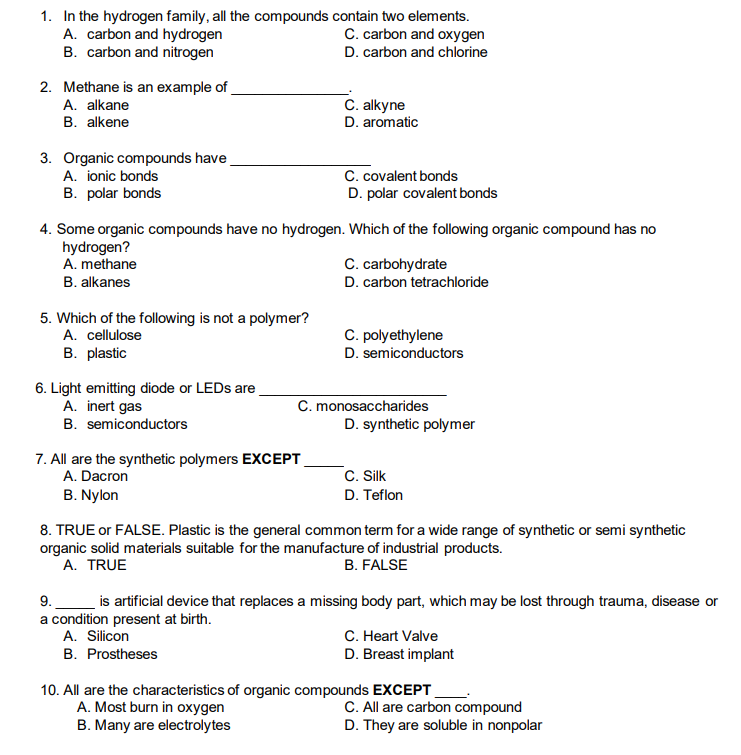1. In the hydrogen family, all the compounds contain two elements. A. carbon and hydrogen B. carbon and nitrogen C. carbon and oxygen D. carbon and chlorine 2. Methane is an example of C. alkyne D. aromatic A. alkane B. alkene 3. Organic compounds have A. ionic bonds C. covalent bonds D. polar covalent bonds B. polar bonds 4. Some organic compounds have no hydrogen. Which of the following organic compound has no hydrogen? A. methane B. alkanes C. carbohydrate D. carbon tetrachloride 5. Which of the following is not a polymer? A. cellulose C. polyethylene D. semiconductors B. plastic 6. Light emitting diode or LEDS are A. inert gas C. monosaccharides D. synthetic polymer B. semiconductors 7. All are the synthetic polymers EXCEPT A. Dacron C. Silk B. Nylon D. Teflon 8. TRUE or FALSE. Plastic is the general common term for a wide range of synthetic or semi synthetic organic solid materials suitable for the manufacture of industrial products. A. TRUE B. FALSE 9. is artificial device that replaces a missing body part, which may be lost through trauma, disease or a condition present at birth. A. Silicon C. Heart Valve D. Breast implant B. Prostheses 10. All are the characteristics of organic compounds EXCEPT A. Most burn in oxygen B. Many are electrolytes C. All are carbon compound D. They are soluble in nonpolar
1. In the hydrogen family, all the compounds contain two elements. A. carbon and hydrogen B. carbon and nitrogen C. carbon and oxygen D. carbon and chlorine 2. Methane is an example of C. alkyne D. aromatic A. alkane B. alkene 3. Organic compounds have A. ionic bonds C. covalent bonds D. polar covalent bonds B. polar bonds 4. Some organic compounds have no hydrogen. Which of the following organic compound has no hydrogen? A. methane B. alkanes C. carbohydrate D. carbon tetrachloride 5. Which of the following is not a polymer? A. cellulose C. polyethylene D. semiconductors B. plastic 6. Light emitting diode or LEDS are A. inert gas C. monosaccharides D. synthetic polymer B. semiconductors 7. All are the synthetic polymers EXCEPT A. Dacron C. Silk B. Nylon D. Teflon 8. TRUE or FALSE. Plastic is the general common term for a wide range of synthetic or semi synthetic organic solid materials suitable for the manufacture of industrial products. A. TRUE B. FALSE 9. is artificial device that replaces a missing body part, which may be lost through trauma, disease or a condition present at birth. A. Silicon C. Heart Valve D. Breast implant B. Prostheses 10. All are the characteristics of organic compounds EXCEPT A. Most burn in oxygen B. Many are electrolytes C. All are carbon compound D. They are soluble in nonpolar
Chemistry: An Atoms First Approach
2nd Edition
ISBN:9781305079243
Author:Steven S. Zumdahl, Susan A. Zumdahl
Publisher:Steven S. Zumdahl, Susan A. Zumdahl
Chapter21: Organic And Biological Molecules
Section: Chapter Questions
Problem 154CP
Related questions
Question

Transcribed Image Text:1. In the hydrogen family, all the compounds contain two elements.
A. carbon and hydrogen
B. carbon and nitrogen
C. carbon and oxygen
D. carbon and chlorine
2. Methane is an example of
A. alkane
B. alkene
C. alkyne
D. aromatic
3. Organic compounds have
C. covalent bonds
D. polar covalent bonds
A. ionic bonds
B. polar bonds
4. Some organic compounds have no hydrogen. Which of the following organic compound has no
hydrogen?
A. methane
C. carbohydrate
D. carbon tetrachloride
B. alkanes
5. Which of the following is not a polymer?
A. cellulose
B. plastic
C. polyethylene
D. semiconductors
6. Light emitting diode or LEDS are
A. inert gas
B. semiconductors
C. monosaccharides
D. synthetic polymer
7. All are the synthetic polymers EXCEPT
A. Dacron
C. Silk
B. Nylon
D. Teflon
8. TRUE or FALSE. Plastic is the general common term for a wide range of synthetic or semi synthetic
organic solid materials suitable for the manufacture of industrial products.
A. TRUE
B. FALSE
is artificial device that replaces a missing body part, which may be lost through trauma, disease or
a condition present at birth.
A. Silicon
9.
C. Heart Valve
D. Breast implant
B. Prostheses
10. All are the characteristics of organic compounds EXCEPT
A. Most burn in oxygen
C. All are carbon compound
D. They are soluble in nonpolar
B. Many are electrolytes
Expert Solution
This question has been solved!
Explore an expertly crafted, step-by-step solution for a thorough understanding of key concepts.
Step by step
Solved in 2 steps

Knowledge Booster
Learn more about
Need a deep-dive on the concept behind this application? Look no further. Learn more about this topic, chemistry and related others by exploring similar questions and additional content below.Recommended textbooks for you

Chemistry: An Atoms First Approach
Chemistry
ISBN:
9781305079243
Author:
Steven S. Zumdahl, Susan A. Zumdahl
Publisher:
Cengage Learning

Chemistry
Chemistry
ISBN:
9781305957404
Author:
Steven S. Zumdahl, Susan A. Zumdahl, Donald J. DeCoste
Publisher:
Cengage Learning


Chemistry: An Atoms First Approach
Chemistry
ISBN:
9781305079243
Author:
Steven S. Zumdahl, Susan A. Zumdahl
Publisher:
Cengage Learning

Chemistry
Chemistry
ISBN:
9781305957404
Author:
Steven S. Zumdahl, Susan A. Zumdahl, Donald J. DeCoste
Publisher:
Cengage Learning


Chemistry & Chemical Reactivity
Chemistry
ISBN:
9781337399074
Author:
John C. Kotz, Paul M. Treichel, John Townsend, David Treichel
Publisher:
Cengage Learning

Chemistry & Chemical Reactivity
Chemistry
ISBN:
9781133949640
Author:
John C. Kotz, Paul M. Treichel, John Townsend, David Treichel
Publisher:
Cengage Learning
